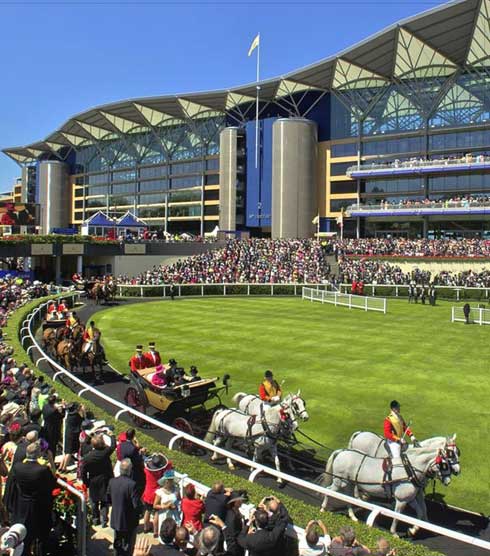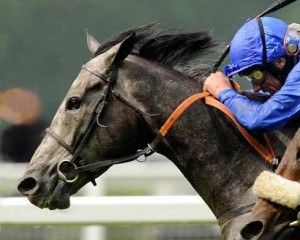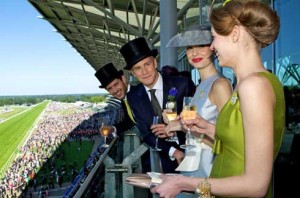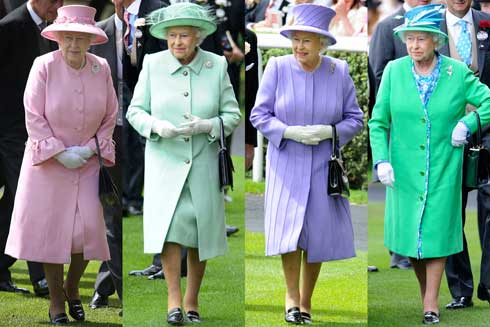Royal Ascot a Regal Scene
By Paula Parisi June 4, 2013
The Queen's arrival via royal procession marks the official opening of each day at Ascot. (Photo courtesy ascot.co.uk)
The international racing scene heats up with U.S. fans getting front-row seats at the 2013 Royal Ascot meet, June 18-22, just West of London, not far from the iconic Windsor Castle.
The 2011 Kentucky Derby winner Animal Kingdom, who went on to win the $10 Million Dubai World Cup earlier this year, seeks to cap his stellar career with a win on the Queen’s racecourse.
The stateside superstar will compete on opening day, in the Queen Anne Stakes, before retiring to stud at age five. U.K.-based oddsmaker William Hill – Your home for the 2013 Royal Ascot Races is sending the Animal off at 6/4 and the stateside entry is creating something of a continental sensation.
There was only one race in which Animal Kingdom finished worse than second in 11 starts — the 2011 Belmont Stakes, where he stumbled badly coming out of the gate and ended up sixth.
The Brits love their horses, and the Queen Anne Stakes for 4-year-olds-and-up is one in a string of prestigious races that highlight the glamorous Royal Ascot Meet, an event interwoven into the very fabric of British culture. Founded by Queen Anne in 1711, the event it steeped in tradition. Patronized by 11 monarchs, each day of the meet starts with a “Royal Procession” that heralds her majesty the Queen and her party arriving in horse-drawn carriages that then parade around the track for racegoers.
This royal procession dates back to the 1820s and the reign of King George IV, when it was referred to as the Royal Parade or Royal Drive.
The event merits an entry at www.royal.gov.uk, the official website of the British Monarchy. The site explains that “the Royal Enclosure is at the heart of Royal Ascot,” with entry restricted to existing member who have attended for four years and those they sponsor.
“Within this area, gentlemen are required to wear morning dress with a top hat and ladies must wear formal day wear.” The origin of the Ascot tradition can be traced back to around the time of the running of Ascot’s most famous race, The Gold Cup, which was inaugurated in 1807 and remains to this day the most important long distance horse race on the flat anywhere in the world. At that time, Beau Brummell, a close friend of the Prince Regent, decreed that men of elegance should wear “waisted black coats and white cravats with pantaloons.” And so a tradition was born!
Last year, a new dress code was introduced and race staff began handing out free “fascinators” (variously described as a “small hat” or “large hair ornament,” depending on the source consulted) and pashmina shawls to those deemed sartorially lacking. Instructive turorials abound. Of course if you’re betting online you won’t have to worry about that!
The Ascot races take place on the grass, which in and of itself makes the meet special. The Queen herself has owned 11 past winners at Ascot. Most of the races are sprints, offering horses and jockeys a different type of test, but one that has taken on increasing importance in the U.S., where in 1990 there were very few Grade 1 races under a mile for 3-year-olds-and-up. As of today, there are 20, which the Paulick Report characterizes as “a 20-fold increase in 30 years.”
The Prince of Wales’s Stakes, established in 1862, is arguably the most important race of the Royal Meeting, having in the past showcased such Thoroughbred superstars as Rewilding, Byword, Manduro and Ouija Board.
Fashionistas will want to check their feeds Thursday for Gold Cup Day, also known as “Ladies’ Day.” Although Royal Ascot week makes a veritible catwalk of the Windsor Great Park, a 4,800-acre retreat where the racecourse is situated, about an hour outside of London, this is the say when designers and milliners send out the big guns.
The final day of Ascot climaxes with the Diamond Jubilee Stakes, the second British leg of the Global Sprint Challenge and one of Britain’s two top-purse sprint races, along with the Darley July Cup at Newmarket.
Trophies for the “QIPCO Royal Ascot Top Jockey” and “QIPCO Royal Ascot Top Trainer” are presented on the final day to the jockey and trainer amassing the most wins during the week. All seven Group One races at Royal Ascot are part of the QIPCO British Champions Series.
While there is a degree of pomp and circumstance surrounding this Royal Meet, a relaxed family atmosphere is the rule in most spectator areas, making this a recommended tourist stop for equestrian travelers. This year marks the debut of the the Royal Ascot Express, a new train line that runs directly from Waterloo Station to the park.
For more information, visit ascot.co.uk
Short URL: https://theequestriannews.com/?p=15393





